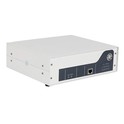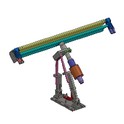As a supplier of the ResoLab-1000 Lab Grade Ultrasonicator, I understand that users may encounter various common problems during the operation of this equipment. In this blog, I will share some practical troubleshooting methods to help you quickly solve these issues and ensure the normal operation of your laboratory work.
1. No Power or Failure to Start
One of the most common problems users may face is that the ResoLab-1000 Ultrasonicator fails to power on or start. There could be several reasons for this:
Check the Power Supply
First, make sure the power cord is properly plugged into both the ultrasonicator and the electrical outlet. Sometimes, a loose connection can cause power issues. Additionally, check if the outlet is functioning correctly by plugging in another device. If the outlet is not working, you may need to contact an electrician to fix it.
Fuse or Circuit Breaker
Inspect the fuse of the ultrasonicator. A blown fuse can prevent the device from receiving power. If the fuse is blown, replace it with a new one of the same rating. Also, check the circuit breaker in your electrical panel. If it has tripped, reset it and try to start the ultrasonicator again.
Internal Electrical Components
If the power supply and fuses are all normal, there may be a problem with the internal electrical components of the ultrasonicator. In this case, it is recommended to contact our professional technical support team. They have the expertise and tools to diagnose and repair internal electrical issues. Our team can be reached through the official channels on our website ResoLab-1000 Lab Grade Ultrasonicator.
2. Insufficient Ultrasonic Output
Another common problem is that the ultrasonicator does not produce enough ultrasonic energy. This can affect the efficiency of sample processing.
Probe or Horn Issues
The probe or horn of the ultrasonicator is a critical component for generating ultrasonic waves. Check if the probe is properly installed and tightened. A loose probe can result in energy loss. Also, inspect the probe for any signs of damage, such as cracks or wear. If the probe is damaged, it needs to be replaced. You can order a new probe from our official store on the ResoLab-1000 Lab Grade Ultrasonicator website.
Amplitude Settings
Verify the amplitude settings on the ultrasonicator. If the amplitude is set too low, the ultrasonic output will be insufficient. Adjust the amplitude according to the requirements of your sample processing. However, do not set the amplitude too high, as it may damage the probe or the samples.
Liquid Level and Viscosity
The liquid level and viscosity in the sample container can also affect the ultrasonic output. Make sure the liquid level is within the recommended range. If the liquid is too viscous, it can absorb more ultrasonic energy, resulting in reduced output. You may need to dilute the sample or use a different container with better acoustic properties.
3. Excessive Noise or Vibration
Excessive noise or vibration during the operation of the ultrasonicator can be a sign of problems.
Mounting and Stability
Check if the ultrasonicator is properly mounted on a stable surface. An unstable surface can cause the device to vibrate excessively. Make sure all the mounting screws are tightened and the device is level.
Loose Components
Inspect the internal components of the ultrasonicator for any loose parts. Loose bolts, nuts, or other components can cause noise and vibration. Tighten all the loose parts carefully. If you are not sure which parts are loose, it is best to contact our technical support team for assistance.
Probe Alignment
The alignment of the probe can also affect the noise and vibration levels. Ensure that the probe is aligned correctly with the sample container. A misaligned probe can cause uneven distribution of ultrasonic energy and lead to increased noise and vibration.
4. Overheating
Overheating is a serious problem that can damage the ultrasonicator and affect its performance.
Cooling System
The ResoLab-1000 Ultrasonicator is equipped with a cooling system to prevent overheating. Check if the cooling fan is working properly. Make sure there are no obstructions blocking the air intake or exhaust vents. Clean the vents regularly to ensure good air circulation.
Duty Cycle
The duty cycle of the ultrasonicator refers to the ratio of the operating time to the total time. If the duty cycle is set too high, the device may overheat. Follow the recommended duty cycle in the user manual. If you need to run the ultrasonicator for a long time, allow it to cool down periodically.
Ambient Temperature
The ambient temperature of the laboratory can also affect the temperature of the ultrasonicator. Make sure the laboratory is well-ventilated and the temperature is within the recommended range. If the ambient temperature is too high, consider using additional cooling equipment, such as air conditioners.
5. Display or Control Panel Issues
Problems with the display or control panel can make it difficult to operate the ultrasonicator.
Screen Damage
Inspect the display screen for any signs of damage, such as cracks or scratches. If the screen is damaged, it may need to be replaced. Contact our technical support team to order a new display screen and get instructions on how to replace it.
Button Malfunction
If some of the buttons on the control panel are not working properly, try cleaning them with a soft cloth. Sometimes, dirt or debris can cause button malfunctions. If cleaning does not solve the problem, there may be an internal issue with the control panel. In this case, it is recommended to contact our professional technicians for repair.


Other Considerations
In addition to the above common problems, there are some other factors that may affect the performance of the ResoLab-1000 Ultrasonicator.
Sample Compatibility
Make sure the samples you are processing are compatible with the ultrasonicator. Some samples may contain substances that can corrode the probe or other components of the device. Refer to the user manual for a list of compatible samples.
Regular Maintenance
Regular maintenance is essential to keep the ultrasonicator in good working condition. Follow the maintenance schedule in the user manual, which includes cleaning the device, lubricating moving parts, and inspecting the components regularly.
If you are still experiencing problems with your ResoLab-1000 Lab Grade Ultrasonicator after trying the above troubleshooting methods, do not hesitate to contact our professional technical support team. We are committed to providing you with the best solutions and ensuring the smooth operation of your laboratory work.
In addition to the ResoLab-1000, we also offer other models of lab grade ultrasonicators, such as the ResoLab-2000 Lab Grade Ultrasonicator and the ResoLab-500 Lab Grade Ultrasonicator. These models have different features and specifications to meet the diverse needs of our customers. If you are interested in purchasing a new ultrasonicator or upgrading your existing one, please feel free to contact us for more information and to discuss your specific requirements.
We look forward to establishing a long - term partnership with you and providing you with high - quality products and excellent service.
References
- ResoLab-1000 Lab Grade Ultrasonicator User Manual
- Technical documentation provided by the ResoLab Ultrasonicator manufacturing team






